Introduction
Welcome to the fascinating world of Bitcoin and cryptocurrency! As an investor and technology entusiast, I can tell you that Bitcoin is more than just a digital asset. It’s a revolution in the financial world. However, as exciting as Bitcoin and cryptocurrencies are, they also come with their fair share of controversies and debates about bitcoin energy.
One of the main concerns raised by experts worldwide is the energy consumption associated with Bitcoin mining. But before I dive into that, I need to explain the process of mining itself.
Bitcoin Mining Process
Bitcoin mining is the process of validating transactions and adding them to the Bitcoin blockchain. Miners use powerful computers to solve complex mathematical problems. Once they solve them, they add a “block” of transactions to the blockchain. In return, they’re rewarded with new bitcoins. This process is crucial for maintaining the security and integrity of the network.
However, mining is not a simple task. It requires powerful hardware and a lot of electricity. This high energy consumption has been at the center of many debates about the sustainability of Bitcoin. But how much energy does it really consume, and how does it compare to traditional currencies?
The Energy Consumption
The energy consumption of mining is immense. According to the Cambridge Centre for Alternative Finance, Bitcoin consumes more energy than entire countries, such as Sweden or Malaysia. This high energy consumption is mainly due to the computational power required to mine this cryptocurrency. The more powerful the computer, the more electricity it uses.
Bitcoin Electricity Consumption Graph
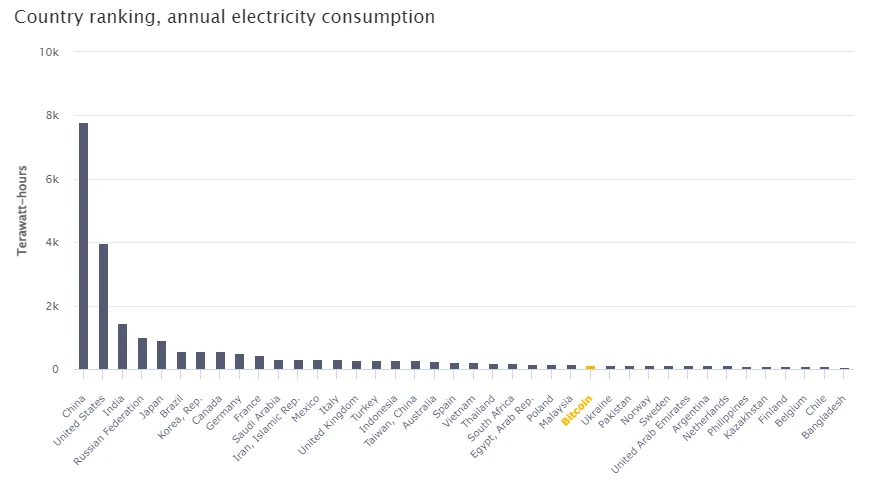
That’s true mining consuming a lot of energy, but still on the graph you can see on thing. It’s still less then relatively good developed conuntries like Poland or South Africa. I am not mantioning about big and very developed countries like China or US.
To put it into perspective, a single Bitcoin transaction could power an average U.S. household for over 24 days. This highlights the staggering amount of energy consumed by it. But how does this compare to traditional currencies?
Comparing Bitcoin Energy
When we compare the energy usage of Bitcoin to traditional currencies, the difference is striking. According to a study conducted by the Dutch Bank ING, “golden currency” transactions consume 200,000 times more energy than a Visa transaction. This is mainly because traditional banking systems don’t require vast computational power like Bitcoin.
Bitcoin and Visa Energy Consumption Graph
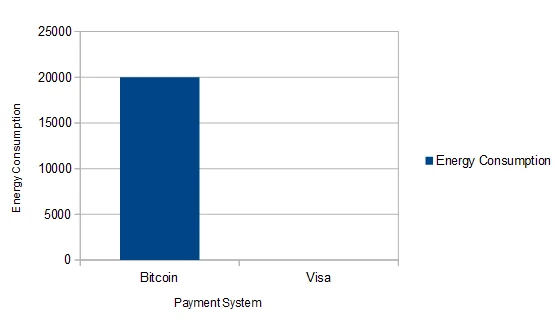
However, it’s important to note that while individual transactions consume more energy.
The difference is huge, as shown in the graphics.
The overall energy consumption of the traditional banking system is still much higher. This is because traditional banking involves physical infrastructure. Such as buildings and ATMs, which also consume energy.
How will the situation change then?
According to research, Galaxy Digital Bitcoin does not use that much energy. Please look at the graphic below.
Bitcoin and Banking Energy Consumption Graph
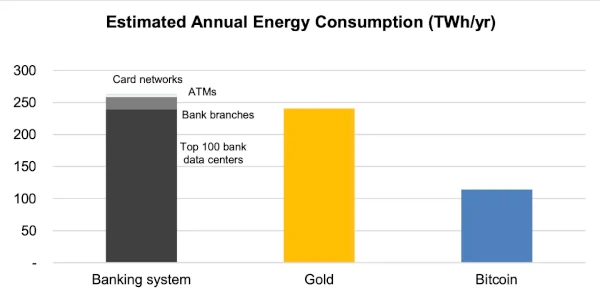
Without a doubt, the traditional banking system consumes much more energy than Bitcoin.
In this case, the cryptocurrency network is treated as a global international payments network, because Bitcoin has such a network. In the energy consumption comparison, calculations for the 100 largest traditional banks in the world were used.
This comparison is justified by the fact that Bitcoin has the potential to replace the traditional banking system. All this, of course, is subject to worldwide adoption. Then regulation and acceptance among the nations of the world. For now, there is still a long way to go.
Having written all this, it’s time to move on to the next important issue. Especially in Europe, which has made environmental protection a point of honor, i.e. the point regarding the impact of Bitcoin on the environment.
However, before I move on to this point, I would like to present one more graphic. This graphic should silence the big opponents of “golden cryptocurrency” or environmental defenders. Take a look at the rest for yourself.
Bitcoin Energy Share Graph
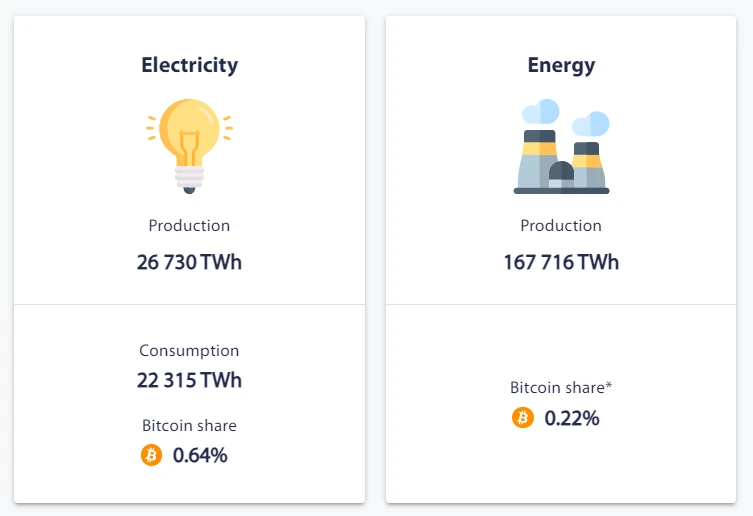
The graphic shows what share of the energy costs of consumption and production goes to Bitcoin. Compared to the scale of our globe. Any questions ?
Now it’s time to discuss the next point, i.e. environmental issues, which I mentioned a little earlier.
Digression
Since people care so much about energy efficiency. It may be time to start early on optimizing losses associated with traditional forms of energy sources.
Energy Losses Graph
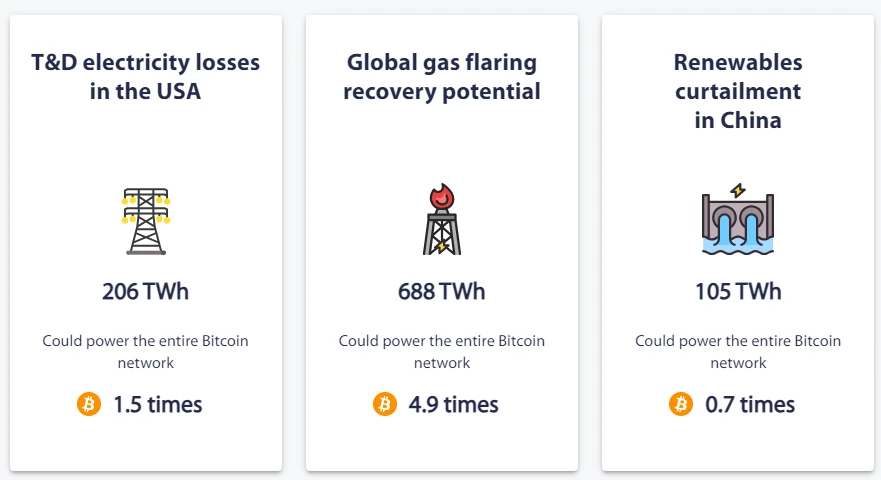
Transforming the losses of just one energy source, whether in the US or China, would make a huge difference. This would be enough to power 70% of the Bitcoin network (in the worst case scenario).
The Environmental Impact of Bitcoin
The environmental impact of this cryptocurrency energy consumption is a growing concern. The extensive use of electricity in mining contributes substantially to carbon emissions. In fact, I will refer once again to the research conducted by the Cambridge Bitcoin Electricity Consumption Index. I recommend checking out The Cambridge Center for Alternative Finance (CCAF) for energy and pollution statistics related to Bitcoin.
In my opinion, these are reliably and objectively conducted studies. I can undoubtedly recommend this source of knowledge.
It’s time to look at some graphics and then discuss them.
Bitcoin Environmental Influence Graph
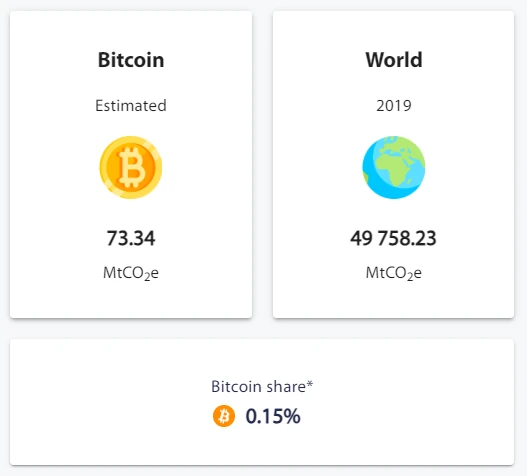
Data on Co2 pollution refer to 2019. Bitcoin accounts for only 0.15% of Co2 pollution. Is that a lot? The next two graphics for comparison.
Greenhouse gas emissions and Bitcoin Graph
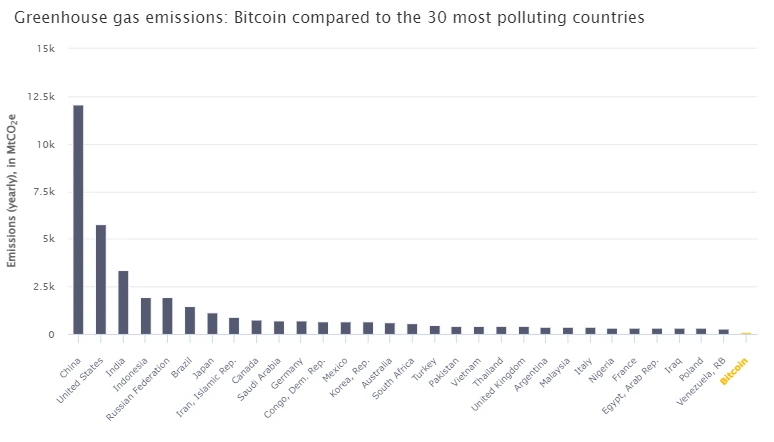
The problem of Co2 emissions is common in developed countries. Will people suddenly stop using combustion cars and stop insulating their homes, offices and warehouses?
How does this apply to Bitcoin. Is there any justification for comparing the entire country to this cryptocurrency network?
Well, in the author’s opinion it makes sense.
Once again, I will mention that the Bitcoin network is decentralized and worldwide. It is true that it is not in one country, but this is the essence of creating decentralized blockchain networks. That’s part of innovation.
The last graphic concerns gold mining in the world.
Bitcoin and Gold Mining Co2 Emission Graph
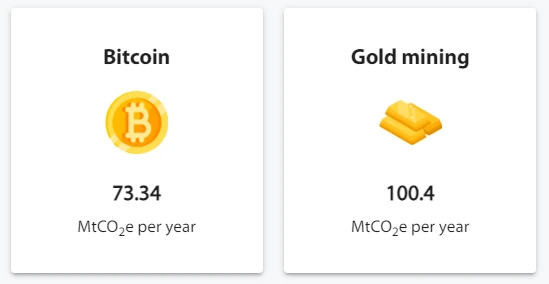
Environmental pollution associated with gold mining is 37% greater than “golden cryptocurrency” mining. Will people suddenly stop mining gold in the world?
It is doubtful whether gold mining will increase by how much it will be possible. Given this, environmental pollution from gold mining will increase. Unless humanity comes up with an idea how to extract gold while polluting the environment as little as possible.
The costs of such an invention are enormous. Maybe there’s something I don’t know about.
It’s time to tackle the next point of energy consumption on earth with cryptocurrency mining.
Bitcoin and Energy Usage Around the World
Let’s take a look at some case studies of Bitcoin and energy usage around the world. In China, which is responsible for over 65% of global mining, the energy consumption is staggering. According to a study published in Nature Communications, China’s Bitcoin energy consumption is expected to peak in 2024 at 296.59 terawatt-hours of electricity.
Meanwhile, in countries like Iceland and Georgia, this cryptocurrency mining is powered by renewable energy. Reducing its environmental impact. These case studies highlight the varying impacts of mining on energy consumption worldwide.
Does this mean that Bitcoin should not be an investment for years? Well, quite the opposite. I’ll jump to the next point to explain this.
The Future of Bitcoin and Renewable Energy Solutions
Looking ahead, the future of Bitcoin could be shaped by renewable energy solutions. As the world strives for sustainability, the Bitcoin community is exploring ways to reduce its energy footprint. Some miners are turning to renewable energy sources. Such as solar and wind, to power their mining operations.
Moreover, advancements in technology could lead to more energy-efficient mining hardware.
Bitcoin Electrocity Consumption by Source Graph

As you can see, the share of coal as an energy source is decreasing every year. This energy source is considered the most destructive medium.
I’m not going to enter into this discussion.
Either way, over the last three years visible in the graphic, the share of gas and nuclear energy has been increasing. When it comes to the share of renewable sources, there is also an increase.
However, it should be added that there are few economies in the world that only use renewable sources to obtain energy. Technology is needed to enable more effective use of such sources.
Currently, energy obtained from renewable sources is very ineffective. Of course, I mean here in comparison to such energy sources as gas, nuclear energy or that hated coal.
Let me jump to next point about role of cryptocurrency in sustainable developement. It should be interesting point as well.
The Role of Cryptocurrency in Sustainable Development
Cryptocurrency has a crucial role to play in sustainable development. With its decentralized nature, it can provide financial services to the unbanked populations, promoting economic growth and reducing poverty.
Furthermore, blockchain, the technology underpinning Bitcoin, can be used to track and verify green initiatives. Then contributing to environmental sustainability. As an example I could present some actual blockchain projects related to green energy only.
I promise doing it, but another time in anothe article.
By now on, let’s talk about some controversies around energy consumption.
Controversies Surrounding Bitcoin Energy Consumption
The controversies surrounding Bitcoin energy consumption cannot be ignored. While Bitcoin proponents argue that its energy consumption is justified by its benefits, critics say it’s unsustainable. To be honest, I am not surprise.
However, it’s essential to remember that every new technology comes with its challenges. This global project is exeptional project, but in this case there is no exception. As we continue to explore and innovate. Then we can find ways to make Bitcoin more energy-efficient and environmentally friendly.
Conclusion
So, is Bitcoin’s energy footprint justifiable? On one hand, Bitcoin provides significant benefits, such as financial freedom, privacy, and the potential for economic growth.
On the other hand, its energy consumption and environmental impact are undeniable.
However, with the advent of renewable energy solutions and more energy-efficient technology. The future of Bitcoin might be greener than we think. As we continue to navigate the world of Bitcoin and cryptocurrency. It’s crucial to balance innovation with sustainability. Only then can we truly harness the potential of this groundbreaking technology.

Leave a Reply
You must be logged in to post a comment.